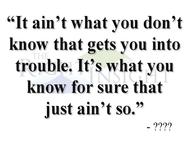Know/Imagine/Project - ORIGINAL CONTENT
- By:
- Edward A. Reid Jr.
- Posted On:
- Oct 31, 2023 at 7:00 AM
- Category
- Climate Change
Know;
1a(1) : to perceive directly : have direct cognition of
2a : to be aware of the truth or factuality of : be convinced or certain of
Imagine:
1: to form a mental image of (something not present)
2: suppose, guess
3: to form a notion of without sufficient basis
Project
1a : to devise in the mind : design
b : to plan, figure, or estimate for the future
Source: Merriam-Webster
We “know” what can be observed or measured, either from personal experience or from the experience of others, past and present. However, there are limits to our knowledge, imposed by our limited exposure or the reliability of the reporting of others with different or broader experience, or with agendas. What we “know” about the past becomes less detailed and less certain the further it is removed in time from the present, especially in periods prior to direct measurement, when what we “know” is based on proxies. In the interpretation of proxies, what we “know” frequently is more what we believe.
As what we “know” transitions from contemporary observation and measurement to recorded observation to interpretation of proxies we are forced to imagine details for which we have no proxies or for which the proxies are ambiguous. We are forced to imagine and develop scenarios which appear to be consistent with the proxy information available. The existence of multiple scenarios based on available proxies clearly marks the transition from “know” to “imagine”, since we cannot “know” two things which are inconsistent or in conflict with each other.
The future is uncertain and, like the past, becomes less certain the longer the timeframe being considered. Regarding the future, over any timeframe, we cannot “know” anything. We are reduced to projecting futures based on our knowledge of the present and the past. Uncertainties regarding details of conditions in the past and present are magnified as those uncertainties are projected into the future. Uncertainties regarding the effects of factors which might influence projections of potential future conditions result in future scenarios which diverge into the projected future. It is not possible to know which, if any, of these future scenarios is accurate.
There is also significant risk in attempting to analyze what we measure or observe based on what we “know” about the past or about conditions which existed when the event occurred. This is the intent of “attribution science” which purports to model a recent event and then calculate how that event might have been affected by observed conditions at the time of the event. Attribution modeling tells us, on one hand, that a particular event could not have happened without the presence of an event or change we have observed; or, on the other hand, that an event was more likely, or more intense, or otherwise varied because of the occurrence of an event or change we have observed. These “attribution studies” are based, not on what we “know”, but rather on what we “believe” about what we “know”. Regrettably, they are frequently presented as certainty, though they lack sufficient basis for such certainty.
“It ain’t what you don’t know that gets you into trouble. It’s what you know for sure that just ain’t so.” (Attribution uncertain)


